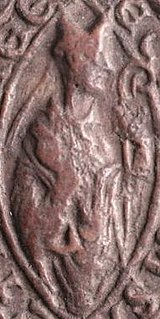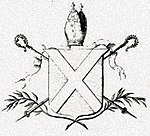Related Research Articles

The Bishop of St. Andrews was the ecclesiastical head of the Diocese of St Andrews in the Catholic Church and then, from 14 August 1472, as Archbishop of St Andrews, the Archdiocese of St Andrews.
Cellach II is the fourth alleged Bishop of the Scots, the predecessor of the later St Andrews bishopric.

Guillaume or William de Malveisin was Chancellor of Scotland, Bishop of Glasgow (1199/1200–1202) and then Bishop of St. Andrews (1202–1238).
Hugh the Chaplain was the royal Chaplain of King William I of Scotland before becoming Bishop of Cell Rígmonaid (St Andrews), the highest ranking Scottish see of the period. After the death of Bishop Richard, King William selected Hugh to succeed to the bishopric in 1178. However, unbeknown to the king, the chapter elected their archdeacon, John l'Escot, as bishop. The king saw to Hugh's election and consecration in the same year. There followed a five-year struggle for the bishopric. John travelled to appeal to Pope Alexander III, who quashed the case of Hugh and sent to Scotland a man named Alexius as legate. Alexius obtained entrance to William's kingdom, and consecrated John at Holyrood Abbey in the presence of four other Scottish bishops, in the year 1180. Nevertheless, the struggle continued, and in 1183, both John and Hugh resigned their rights. Despite the fact that Hugh received the bishopric and John took the Bishopric of Dunkeld in compensation, dispute over revenues continued. When Hugh refused to answer his summons to Rome in 1186, he was suspended and excommunicated, with the diocese being put under interdict. Hugh travelled to Rome and obtained absolution, but he died of the pestilence in that city a few days later.
Galfredus, Galfred or Geoffrey de Liberatione was Bishop of Dunkeld and Bishop-postulate of St Andrews. He was a clerk to King Alexander II of Scotland as early as 1219, as well as being a canon of Dunkeld and precentor of Glasgow. He was elected to the bishopric of Dunkeld in 1236. After an investigation by Pope Gregory IX regarding a defect of birth possessed by Galfred, he was confirmed as bishop in sometime in 1237.
James Bane was Bishop of St. Andrews for a brief period in the early 14th century. In his earlier career, James had been a canon of Aberdeen and prebendary of Cruden.
William de Landallis was a 14th-century Bishop of St. Andrews.
Thomas Stewart was an illegitimate son of King Robert II of Scotland. In 1380, Avignon Pope Clement VII provided Thomas with the Archdeaconry of the Bishopric of St. Andrews, as well as the canonry of Stobo in the Bishopric of Glasgow. In 1389, the king petitioned and obtained for Thomas from the Pope the right to hold the deanery of the Bishopric of Dunkeld along with his other offices, and in 1393, the Pope provided a canonry in the Bishopric of Brechin. In this period, Archdeacon Thomas obtained a Bachelor of Canon Law at the University of Paris.
Jocelin was a twelfth-century Cistercian monk and cleric who became the fourth Abbot of Melrose before becoming Bishop of Glasgow, Scotland. He was probably born in the 1130s, and in his teenage years became a monk of Melrose Abbey. He rose in the service of Abbot Waltheof, and by the time of the short abbacy of Waltheof's successor Abbot William, Jocelin had become prior. Then in 1170 Jocelin himself became abbot, a position he held for four years. Jocelin was responsible for promoting the cult of the emerging Saint Waltheof, and in this had the support of Enguerrand, Bishop of Glasgow.
Enguerrand was a twelfth-century bishop of Glasgow. He had previously been Archdeacon of Teviotdale, and had served king Máel Coluim IV as Chancellor of Scotland between 1161 and 1164. He was elected Bishop of Glasgow on Sunday, 20 September 1164, and consecrated on 28 October at the hands of Pope Alexander III himself in Sens, France, where the Pope was then resident. He did not return to the diocese until 2 June 1165. Although he resigned the position of Royal Chancellor upon election to the bishopric, there is charter evidence that he once again became Chancellor in the reign of King William the Lion, probably in the year 1171. Notable actions of his episcopate included, probably on the request of his friend Jocelin, then Abbot of Melrose, the opening of the tomb of the emerging saint Walthoef. He died on 2 February 1174.
John de Leicester was an early 13th-century bishop of Dunkeld. Before becoming bishop, he had been archdeacon of Lothian. He was elected to the bishopric on 22 July 1211. As bishop-elect, he is present when King William of Scotland paid homage to King John of England in 1212. He had been consecrated by June 1212, when a letter from Pope Innocent III to Walter, bishop of Glasgow, and Radulphus, bishop of Brechin, writes of the election and consecration of John, archdeacon of Lothian. John's episcopate would only last a few years; he died on 7 October 1214. His death occurred at Cramond, Midlothian, and was buried on Inchcolm.
Clement was a 13th-century Dominican friar who was the first member of the Dominican Order in Britain and Ireland to become a bishop. In 1233, he was selected to lead the ailing diocese of Dunblane in Scotland, and faced a struggle to bring the bishopric of Dunblane to financial viability. This involved many negotiations with the powerful religious institutions and secular authorities which had acquired control of the revenue that would normally have been the entitlement of Clement's bishopric. The negotiations proved difficult, forcing Clement to visit the papal court in Rome. While not achieving all of his aims, Clement succeeded in saving the bishopric from relocation to Inchaffray Abbey. He also regained enough revenue to begin work on the new Dunblane Cathedral.

Historical treatment of David I and the Scottish church usually emphasises King David I of Scotland's pioneering role as the instrument of diocesan reorganisation and Norman penetration, beginning with the bishopric of Glasgow while David was Prince of the Cumbrians, and continuing further north after David acceded to the throne of Scotland. As well as this and his monastic patronage, focus too is usually given to his role as the defender of the Scottish church's independence from claims of overlordship by the Archbishop of York and the Archbishop of Canterbury.

Andrew Stewart was a 16th-century Scottish noble and cleric. He was a legitimate son of John Stewart, 1st Earl of Atholl and Eleanor Sinclair, daughter of William Sinclair, Earl of Orkney. His paternal grandmother was Joan Beaufort, former queen-consort of Scotland. Andrew chose an ecclesiastical career, held a canonry in Dunkeld Cathedral and was rector of Blair parish church, a church under the control of the earls of Atholl.
John Le Leche was a canon of Dunkeld and prelate during the early 14th century. After the death of Matthew de Crambeth, Bishop of Dunkeld, in 1309, William Sinclair was elected by some of the chapter to the bishopric. John le Leche, however, was elected soon afterwards, and had the support of King Edward II of England. The diocese of Dunkeld lay vacant for three years, while the issue was contested at the Papal see. Pope Clement V appointed James, Cardinal Deacon of St George in Velabro, to judge the issue; but this was resolved when, on 22 May 1311, John de Leche was promoted to the Archbishopric of Dublin. He held the latter for two years. He obtained a charter for the earliest University in Dublin in 1311 but his death, which seems to have been sudden, in 1313 greatly hampered the establishment of the university, and it never flourished, due largely to lack of sufficient funds. It had no connection with the present day Trinity College Dublin, which was founded in 1592.
John de Carrick, a native of Carrick, Scotland, was a 14th-century Chancellor of Scotland and Bishop-elect of Dunkeld. Although John's exact origins are obscure, he seems to have come from a branch of the old native comital family of Carrick. Later evidence suggests he was a graduate of canon law, but the university is not known.

Henry de Lichton [de Lychtone, Leighton] was a medieval Scottish prelate and diplomat, who, serving as Bishop of Moray (1414–1422) and Bishop of Aberdeen (1422–1440), became a significant patron of the church, a cathedral builder, and a writer. He also served King James I of Scotland as a diplomat in England, France, and Italy.
John Bullock O.S.A. was an Augustinian canon and prelate active in the 15th century Kingdom of Scotland. While earning a university degree between 1409 and 1417, Bullock gained several benefices in Scotland, and claimed the headship of St Andrews Cathedral Priory before becoming Bishop of Ross in 1418. He held the latter position until his death, which occurred in either 1439 or 1440.

Albin was a 13th-century prelate of the Kingdom of Scotland. A university graduate, Albin is known for his ecclesiastical career in the diocese of Brechin, centred on Angus in east-central Scotland.
Laurence de Ergadia was a thirteenth-century Scottish bishop. Probably from the MacDougall kindred of Argyll, Laurence had become a Dominican friar and presumably university graduate before being elected Bishop of Argyll, an election which took place sometime between 1262 and 1264. Although the election was quashed by the Pope in 1264, the Pope gave him a fresh provision to the bishopric. Laurence appears intermittently in the records during his three and a half decade episcopate, but his activities in his own diocese are badly recorded. He died as Bishop of Argyll sometime in either 1299 or 1300.
References
- Dowden, John, The Bishops of Scotland, ed. J. Maitland Thomson, (Glasgow, 1912)
- Owen, D.D.R., The Reign of William the Lion: Kingship and Culture, 1143-1214, (East Linton, 1997)
